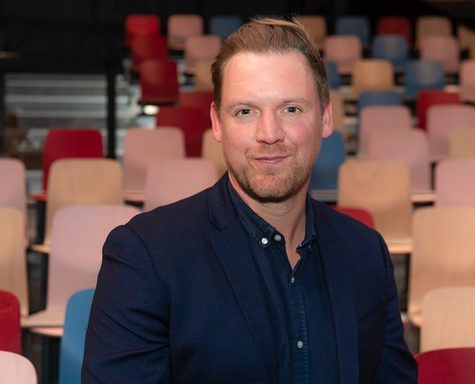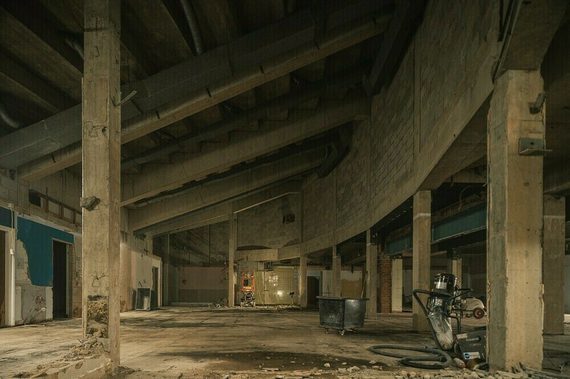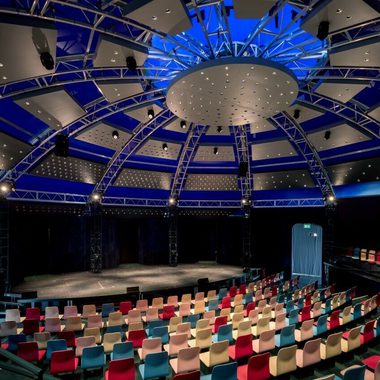Blog: Theatr Clwyd’s Redevelopment
The Long Read (with pictures)
[2,225 words | 10 minute read]
By Liam Evans-Ford | Executive Director
Only when I take a step back and a deep breath do I realise what a massive project this is, and also how life-changing it will be for such a huge number of peopleLiam Evans-Ford

Theatr Clwyd Exterior | Spring 2023
Credit: Dave Jones 2023I took a walk today, as I do every two weeks now – hard hat, hi-vis jacket and steel toe-capped boots - out the back door of our temporary foyer, through the gate in the hoardings that surround the building site, and into the theatre, our home in Flintshire, to see how work is progressing on this massive capital project.
I’m always struck by the sheer scale of the building - it looms over you as you walk in – a testament to the ambition and vision of those civic leaders in the 1970s.
I stand on the main stage - seats removed, carpet ripped out, the theatre silent - I’m really struck, maybe for the first time, what a huge achievement it has been getting to this point.

Liam Evans-Ford | Executive Director
I have the privilege of being Theatr Clwyd’s Executive Director - I’m the other half of the organisation’s leadership team alongside the Artistic Director Kate. I joined in 2016 shortly after Tamara (the previous Artistic Director) arrived.
We both knew that the theatre needed a major redevelopment – it was obvious - water was coming in through the roof, the electrics were rapidly failing, and that’s before you even walked round the foyers and bar which felt dated and tired (with a bizarre smell of overboiled cabbage in certain areas).
Over the last seven years we have also broadened our work significantly – working far more with and for our communities, in a way that hadn’t been envisaged in the design of the building in the 70’s. The horrible reality was that if a major redevelopment of the building didn’t happen then all the amazing work that took place both on and off its stages would be lost - Theatr Clwyd would be no more – it really was that critical.


The first two spaces I walk through are the two places audiences will know and love the most – the main house theatre (known as the Anthony Hopkins Theatre from 1994 onwards) and the studio theatre (known as the Emlyn Williams Theatre from the late 1980’s) – both are being completely refreshed and updated, but both are also being protected to ensure that the key elements of what makes them such brilliant performance spaces isn’t lost.
The main house has incredible sightlines, the acoustic is crisp due to the hand carved bricks that form part of our Grade II listed status, and it’s a surprisingly intimate place for both performers and audiences to share time in.
But it has flaws – the seating is original, threadbare and prone to collapse – the electrics and health & safety are long past their sell-by-date, the accessibility it offers is poor, and the technical elements that support high quality productions (the flying system and orchestra pit being two examples) have routinely failed over the last 15 years.
The studio is, truth be told, my favourite place – it’s totally flexible and holds some of my favourite memories contained within the walls
The studio is, truth be told, my favourite place – it’s totally flexible and holds some of my favourite memories contained within the walls – from seeing my favourite show in there (Insignificance directed by our very own Kate Wasserberg – I must have watched it over ten times during the run!) but it was also where our journey to the Olivier Awards began with the stunning world premiere of Home, I’m Darling. Again, we’re not messing with what works (and works incredibly well) – the electrics are being replaced completely, the balconies and technical box made accessible for the first time, the theatre making capabilities are being improved, and seating renovated.
We’ve been incredibly lucky to have had the support of Flintshire County Council, Welsh Government and the Arts Council of Wales throughout this journey. It’s rare and precious thing to have a local authority who values culture so highly – we work together collaboratively, side by side – our creative engagement team works with social services weekly to run programmes that work with some of the most vulnerable in our communities. They recognise what Theatr Clwyd’s work does – bring people to live, work, visit and stay in Flintshire; generate huge benefit to the local economy; offer employment to hundreds of people - but more than that, at the core arts can make the world a better, happier place to live in.
Down into the foyers and suddenly everything becomes unrecognisable – the 1970s foyers have been ripped out, false ceilings removed, cramped toilets stripped, the bones of the building exposed for the first time since it was built, now echoing and empty.


For most people this is where the biggest difference will be felt – it was said to me not long after I started that whilst Theatr Clwyd has an amazing team that make world class productions, that the audience experience did not match such high standards. The redevelopment will change that for the better, with the front of the building massively expanded, a new restaurant on the first floor, a café to meet friends and family on the ground floor. You don’t need to see a show to enjoy this – it’ll be a gathering point for everyone to meet, relax and spend time. The kitchens which were removed in the 1990s will return, you’ll finally be able to make a night of it from pre-show dinner to post-show drinks.
Toilets? There’s always questions about toilets. Indeed before becoming an executive at a theatre I was told much of my time would be taken up with discussions on toilets (not quite true – but it is always a hot topic!)
We’ll have toilets. So many toilets. Finally the horrific queues of a sold out night (particularly in the ladies) will be a thing of the past. We’ll also have the highest standards of changing places (I’m told these will be the first in North Wales), toilets designed for young children and family use, men’s, women’s, and gender neutral. I told you we would have toilets!!


Everywhere I walk there’s a memory – beautiful memories like the Family Arts Festival where young people painted the windows, but also memories of challenging times, when I stood alone in a building closed because of Covid. The obstacles thrown at us due to Covid actually offer me confidence that navigating such a huge capital project like this is possible – we got through the pandemic which was far more of a challenge.
Looking around at the bare concrete I’m reminded how noisy the bar was, sometimes deafeningly so – we’re working with an acoustic engineer to dampen the noise created by a busy foyer. Keeping the atmosphere and buzz but making sure it’s still a lovely place to be.

The stripping back is most visible in the gallery, the high street of the building, where exhibitions from some of the best UK visual artists to Cosgrove Hall’s puppets have lived. Previously its felt almost cramped, certainly unloved, and definitely cold. Now with the ceilings higher it feels glorious, the light pouring in and that scale hits you – this is a huge space, a huge space for sharing art, showcasing the best of what we have to offer, connecting our foyer, theatres, cinema and community spaces to each other, and for welcoming large numbers of people to our hilltop in North Wales.
Down in the Clwyd room some of the space has disappeared, demolished. It’ll be reinvigorated, revived and refreshed. When the building opened in 1976 this was the heart of community events – weddings, birthdays, wakes and civic events side by side. The new kitchen will make this a civic space again – bringing people together for their own important occasions (although, it’s fair to say, this time it won’t have a chef dedicated to butter – yes, butter – different times indeed! Watch on YouTube).


When we started this journey we were incredibly lucky to secure the services of Howarth Tompkins, the award-winning Sterling Prize architects. They’ve delivered some of the biggest cultural projects in the world, acclaimed venues like the National Theatre, Liverpool Everyman and Bristol Old Vic, and now, they’re delivering for North Wales.

Upstairs and I’m both indoors and outdoors. In the shell of what was, a year ago, a busy marketing and development office, but which now is open to the elements, sunshine and blue skies the only thing above me. It’s not the first time. I was told a story by one of our team who used to work in this office about how, one Christmas, they came in to discover that after a storm a large portion of the roof was missing, the remnants scattered over a neighbouring field. As snow came in, unsure quite what to do in such a situation, they collected the bits of the roof and put it in a pile as panto audiences passed looking quizzical – all in a day’s work. That story is one of many about trying to tame a building that was failing in a range of ways. As I stand in the open air, in what will be our new rehearsal room, I remember the essentials we’re going to achieve, a roof over our heads and time to focus on our audiences and communities rather than dealing with bits of ceiling in a field.
Of course projects like this don’t come along often – huge projects that can be the catalyst for investment and rejuvenation. They’re expensive too. Before this project the most that has ever been raised through private fundraising for a cultural building in Wales was £2.5m. We were told the best we could hope for was £2m. But this is Theatr Clwyd, and we strive to achieve at a high level in everything we do, and now, we’ve raised over £4m – the most ever in Wales, and we’ve still got more to do to deliver the final target for this essential project.


As I head towards the site exit there is the footprint of our new scenic construction workshop – the trenches and footing for what will be a theatrical factory, where sets will be built for shows that will travel around Wales, around the UK, maybe even the world. Sets built by people living and working in Flintshire, keeping the key skills that are vital to making sure the UK has the best cultural industries in the world. Next to the workshop is our plant room – perhaps not the most exciting place, but one that will change our impact on the world significantly. The new building will be gas free - using air source heat pumps to run the building. We’ll harvest solar energy, rain water, have bio diversity on external roofs and walls, and will have the potential to run a carbon positive building in the future.
I take off my hard hat, jacket and boots, and walk round the front of the building towards the car park to drive back to our temporary offices in the centre of Mold. The front of the building is gone now – ripped down to be replaced with a state of the art, modern foyer - not only to offer a bigger, better space for audiences and communities to spend time, but to be less fortress like, more connected to the outside - making the most of those stunning views across the Clwydian range.
I’ve been working towards this essential work for 7 years now, and have been involved in everything from design, conservation and planning, through to funding from both public and private sources. Only when I take a step back and a deep breath do I realise what a massive project this is, and also how life-changing it will be for such a huge number of people.
We are, of course, only halfway there on our journey, when the new building reopens fully in early 2025 it will be glorious, but first we’ve the final pieces in a fundraising jigsaw to find and slot in. This is where we need your help –where you can sponsor a tile, or a dressing room mirror, name a seat, hold a bake sale or give a gift. If you want to find out more then click here.
Finally.
Even with all this happening - we’re still open! Making shows and sharing the best theatre, comedy and music – whether it’s in our temporary venue The Mix next to the Theatre, at our sister venue William Aston Hall in Wrexham or, from The Dolphin Pub in Mold where our immersive production of The Great Gatsby is in residence until the end of the month following a three year run in the West End.
Thank you for reading this, thank you for your support, for continuing to see shows, for being patient in temporary foyers and for being understanding as we make this mammoth dream come true. We’re doing this for all our communities, for our artists, for the people of Flintshire, North Wales and beyond. We’re doing this to make sure our future is bright.
With your help and support it will be.


